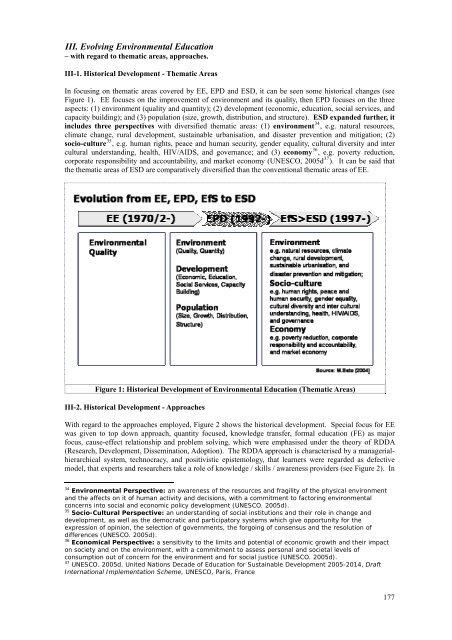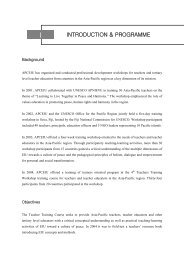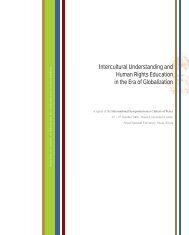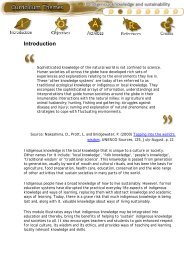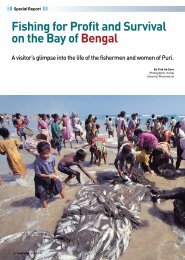REPORT OF UNESCO EXPERT MEETING ON - APCEIU
REPORT OF UNESCO EXPERT MEETING ON - APCEIU
REPORT OF UNESCO EXPERT MEETING ON - APCEIU
You also want an ePaper? Increase the reach of your titles
YUMPU automatically turns print PDFs into web optimized ePapers that Google loves.
III. Evolving Environmental Education<br />
– with regard to thematic areas, approaches.<br />
III-1. Historical Development - Thematic Areas<br />
In focusing on thematic areas covered by EE, EPD and ESD, it can be seen some historical changes (see<br />
Figure 1). EE focuses on the improvement of environment and its quality, then EPD focuses on the three<br />
aspects: (1) environment (quality and quantity); (2) development (economic, education, social services, and<br />
capacity building); and (3) population (size, growth, distribution, and structure). ESD expanded further, it<br />
includes three perspectives with diversified thematic areas: (1) environment 34 , e.g. natural resources,<br />
climate change, rural development, sustainable urbanisation, and disaster prevention and mitigation; (2)<br />
socio-culture 35 , e.g. human rights, peace and human security, gender equality, cultural diversity and inter<br />
cultural understanding, health, HIV/AIDS, and governance; and (3) economy 36 , e.g. poverty reduction,<br />
corporate responsibility and accountability, and market economy (<strong>UNESCO</strong>, 2005d 37 ). It can be said that<br />
the thematic areas of ESD are comparatively diversified than the conventional thematic areas of EE.<br />
Figure 1: Historical Development of Environmental Education (Thematic Areas)<br />
III-2. Historical Development - Approaches<br />
With regard to the approaches employed, Figure 2 shows the historical development. Special focus for EE<br />
was given to top down approach, quantity focused, knowledge transfer, formal education (FE) as major<br />
focus, cause-effect relationship and problem solving, which were emphasised under the theory of RDDA<br />
(Research, Development, Dissemination, Adoption). The RDDA approach is characterised by a managerialhierarchical<br />
system, technocracy, and positivistic epistemology, that learners were regarded as defective<br />
model, that experts and researchers take a role of knowledge / skills / awareness providers (see Figure 2). In<br />
34 Environmental Perspective: an awareness of the resources and fragility of the physical environment<br />
and the affects on it of human activity and decisions, with a commitment to factoring environmental<br />
concerns into social and economic policy development (<strong>UNESCO</strong>. 2005d).<br />
35 Socio-Cultural Perspective: an understanding of social institutions and their role in change and<br />
development, as well as the democratic and participatory systems which give opportunity for the<br />
expression of opinion, the selection of governments, the forgoing of consensus and the resolution of<br />
differences (<strong>UNESCO</strong>. 2005d).<br />
36 Economical Perspective: a sensitivity to the limits and potential of economic growth and their impact<br />
on society and on the environment, with a commitment to assess personal and societal levels of<br />
consumption out of concern for the environment and for social justice (<strong>UNESCO</strong>. 2005d).<br />
37 <strong>UNESCO</strong>. 2005d. United Nations Decade of Education for Sustainable Development 2005-2014, Draft<br />
International Implementation Scheme, <strong>UNESCO</strong>, Paris, France<br />
177


